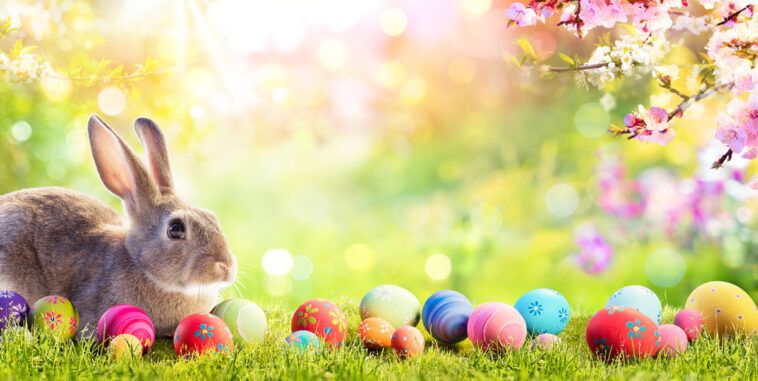When Cadbury Eggs hit the shelves, we know that spring has arrived and Easter is right around the corner. It is a time known for dyed eggs and chocolate bunnies, steeped in cultural traditions and religious practices. However, there is a lot more to today’s Easter traditions than most people know.
In fact, the word Easter can be traced back to the Anglo-Saxon goddess of dawn and springtime, Eastre or Eostre for the Germanic goddess. She represented fertility and was said to have owned a hare on the moon that loved eggs, both of which became symbols related to the goddess. Sound familiar?
Springtime Symbols
Rabbits and eggs are often symbols for spring – a time for the growth of new plants and crops – because they’re also associated with fertility and new life.
The bunny rose in popularity in Europe through folk stories of the Ostara hare and believed to have been brought over to America through German immigrants in the 18th century. The custom of giving eggs at Easter has been traced back to Egyptians, Persians, Gauls, Greeks and Romans. Both have stuck with us today.
Ears or Tails
Real eggs aren’t the only way to get this iconic symbol in your basket. It’s become such a novelty and treat for the Easter holiday that the famous Cadbury brand produces more than 1.5 million of its delightful egg-shaped chocolate crème eggs a year.
After Halloween, Easter has become the biggest candy-consuming holiday, with over 120 million pounds of candy bought each year. Today, 90 million chocolate bunnies are produced each year in the United States. 76 percent of people who buy them prefer to eat the ears on chocolate bunnies first.
While chocolate makes up for most of the candy sold for Easter, more than 16 million jellybeans are consumed and over 1.5 billion marshmallow Peeps are eaten during the holiday. This makes Peeps the most popular non-chocolate Easter candy.
Eggs
So why eat eggs on Easter morning? During the Middle Ages, eggs were one of the foods given up during Lent. Eggs became a popular dish – and even considered a treat – on Easter morning to celebrate the end of Lent.
In medieval times, a festival of egg throwing was held in church, in which the priest would throw a hard-boiled egg to one of the choirboys. It was then tossed from one choirboy to the next. Whoever held the egg when the clock struck noon was the winner and could keep it. Today, the egg toss is a popular activity at Easter festivals and parties.
Between 1885 and 1917, the Russian Tsar, Alexander III, commissioned Peter Carl Faberge to create some of the most expensive Easter eggs as a gift for his wife. Thus began the illustrious jeweled Faberge eggs. Fifty Faberge eggs were made for the Royal family known as the “Imperial” Easter eggs. Due to the Russian Revolution, in which the Romanov Dynasty was overthrown and all the members of the imperial family executed, several eggs were lost or destroyed.
In 2014, one of the eggs was found in a U.S. flea market and nearly melted down for scrap metal before it was identified. Today, a total of 43 Imperial eggs are accounted for and the other 7 left to be found. That is one expensive Easter egg hunt!
7 Egg Facts
1. The tallest chocolate Easter egg ever was made in Italy in 2011, at just over 34 feet in height and a little more than 15,873 pounds.
2. The first chocolate egg was produced in the UK in 1873 by chocolatiers J.S Fry & Sons of Bristol. Two years later John Cadbury made his first Cadbury Easter Eggs.
3. In 2007, a rare jewel-enameled egg sold for a record breaking $18.5 million. Every hour a rooster made of jewels pops up from the top of the Rothschild Faberge Egg, flaps its wings, nods its head and makes a crowing noise.
4. The traditional act of painting eggs is called Pysanka, which originated in Ukraine.
5. Florida held the largest Easter egg hunt in 2007. 9,753 children searched for 501,000 eggs at Cypress Gardens Adventure Park in Winter Haven.
6. Egg dyes were once made out of natural items such as onion peels, tree bark, flower petals and juices.
7. Egg farmers across the country donate more than 11 million eggs to food banks across the nation to help Americans in need.




Comments